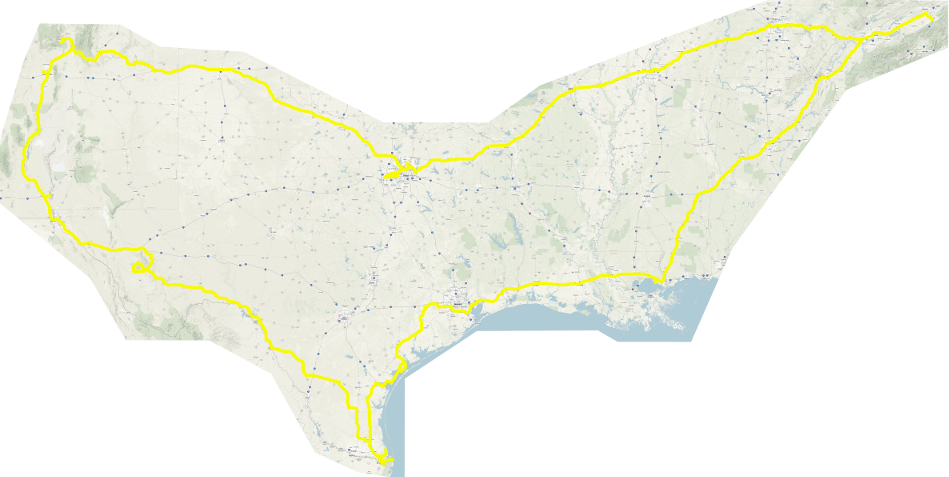
Rio Grande Tour
email Scott Turner
home
album index
Rio Grande Tour
It’s hard to say how we could tear ourselves away from Johnson City, Tennessee, where we greatly enjoy being near family and the beautiful environment. Neverthess, wanderlust struck, so we hit the road!
Houston Space Center
On the third day we reached the Houston Space Center for a tour of space artifacts and NASA facilities.
The space shuttle full scale replica, resting on its 747 carrier.
By a great piece of luck, Jeri Brown, who worked for NASA for many years and knew many of the astronauts personally, gave us a fascinating tour of the facility.
International Space Station mock-up.
An active training and development facility, with mock-ups of many mission capsules.
The only existing complete Saturn V Rocket must be witnessed in person to feel the size, mass, and energy that launched astronauts to the moon.
The original Apollo 11 capsule (on loan from the Smithsonian) which carried the first men on the moon back to Earth, and actual moon rocks brought to Earth by Apollo 16.
Attwater Prairie Chicken National Wildlife Refuge
The Attwater Prairie Chicken National Wildlife Refuge was the first birding destination on our planned itinerary. We saw some birds along the trails, and we were sorry not to see any Prairie Chickens. Later we learned that even birders familiar with the area don’t often see them.
Aransas National Wildlife Refuge
At our next birding destination, the man at the visitor center said that there were lots of little alligators, maybe 3 feet long, and they were no threat. On the trail, what we saw were a substantial number of large alligators! They took some getting used to.
When a trail led to open water, Scott carried our spotting scope in order to get a good look at ducks and shore birds.
Our first life bird species of the trip was Whooping Cranes. They were far in the distance across the flats, barely visible to the unaided eye. This photo was taken through the spotting scope and enlarged.
USS Lexington Museum
The USS Lexington, a World War II era aircraft carrier, was converted to a Naval Air museum and installed in Corpus Christi. The exhibits resonated with both of us, as I served on the aircraft carrier Kitty Hawk in combat operations during the Vietnam War, and Kathy’s father served on the aircraft carrier Wasp during World War II. The Wasp and Lexington were of the same class.
Scott’s entire experiece as a pilot occurred during midshipman training in 1968 in Corpus Christi. He had 3 one-hour training flights in T-34s just like this one. In fact, it could even be one of the planes he flew! The trainee sits in the front seat, while the experienced trainer pilot is in the rear.
Kathy tries out the type of gun which her father supervised during World War II.
This A6 bomber is one type which Scott remembers from the Kitty Hawk.
At the Lexington, a hawk impinged dramatically on our historical venture, flying past us above the flight deck and alighting on the superstructure. A Peregrine Falcon is a treat on any occasion.
Laguna Atacosa National Wildlife Refuge
At Laguna Atacosa National Wildlife Refuge we saw Long-billed Curlews and an armadillo.
Sabal Palms Sanctuary
Sabal Palms Sanctuary is at the southernmost point in Texas, on the Rio Grande. It promised a distinctive collection of birds, and did not disappoint.
Kathy loved the colorful Green Jays. She was sorry not to get a photo of the spectacular Altamira Orioles.
The trails through a palm forest were different from anything we were familiar with.
We saw Least Grebes, although for the most part they liked to hide in an inlet that's protected by a fallen branch. Other birds at Sabal Palms that were life birds for us included
- Black-crested Titmouse
- White-tipped Dove
- Olive Sparrow
- Ladder-backed Woodpecker
- Long-billed Thrasher
The Gulf of Mexico
We went to the coast at Brownsville just to see the Gulf of Mexico. Scott’s reasoning was that if we had spent days skirting this huge obstacle and enjoying its associated lagoons, we should at least take a look at it.
Kathy was surprised that we could drive on the beach, even in our Toyota sedan.
Along the Road
Not long after starting from the Brownsville area we were going northwest and traffic slowed for this. Help was already on the scene.
We paused later in the day at a scenic rest stop. We had already passed through the fascinating ranch country, and had left behind the area which delighted us with many Caracaras perched on the utility poles.
This trip gave us a chance to learn the difference between a Caracara, which has a distinctive face and is similar to a large falcon that doesn’t mind scavenging road kill, and a Chacalaca, which is a big brown chicken-like bird.
McDonald Observatory
That day’s drive brought us to the West Texas town of Fort Davis. This is a small, somewhat touristy place, which is particularly busy during the week of spring break, which is when we happened to be there. We were lucky to book a couple of nights at a nice bed and breakfast, but unfortunately all the slots at the star party were taken. Still, we were able to sign up for a couple of daytime programs at the nearby McDonald Observatory.
This observatory is atop two mountains in the Davis Mountain range, at an altitude of over 6,000 feet.
The 108 inch telescope and its dome atop Mount Locke.
With an effective diameter of 10 meters (309 in), The Hobby-Eberly Telescope atop Mount Fowlkes dwarfs the older 108 inch telescope. Actually it consists of 91 mirrors mounted in a precisely aligned frame.
Fort Davis National Historic Site
Restored barracks of the fort which operated until 1896.
Relics of the Apache Indians who inhabited the area while the fort was active.
A historic interpreter tells about life for the average soldier on the frontier.
What the interior of the barracks was like for the average soldier of the times.
Re-creation of a typical Apache dwelling called a wickiup.
New Mexico Farm & Ranch Heritage Museum
We reached Las Cruces in mid-afternoon, and visited the New Mexico Farm & Ranch Heritage Museum. It seems we were too late in the day for the interesting programs, such as a demonstration of using a machine to milk a cow. It was very windy as we strolled the grounds and got a look at several important varieties of livestock.
With the dry weather, most cactus and yucca were not flowering, but cholla cactus was an exception. Scott got to know the difference between a yucca and a century plant.
Organ Mountains and Dripping Springs
Close by Las Cruces is the Dripping Springs area of the Organ Mountains. When we got there in the morning a number of young hikers were setting out up a very steep trail for the Needles.
We contented ourselves with a more gradual trail of 4 or 5 miles along an arroyo and up to the springs.
In the arroyo, Scott was delayed by 1/2 hour while attempting to get a decent view of some interesting birds. In this photo, Scott pauses on the return from Dripping Springs to look up how to identify some obscure sparrows.
Bosque del Apache National Wildlife Refuge
Bosque del Apache held hundreds of ducks, often predominantly Shovelers. We saw our first Cinnamon Teal, Avocets, Stilts, Gambel’s Quail, and Black Phoebe.
Obviously, the photos do not capture the wonderful birds which were present that day.
Scott had scouted on the eBird.org web site to know what interesting birds to expect. When we got to the Bosque del Apache visitor center, as usual a staff member showed us a map of where birders like to go. After he finished, Scott went back to say he was particularly interested in quail, and where could those be found. The man said, right in the vicinity of this building, especially at the feeder. So we looked out the window, and immediately saw several Gambel’s Quail, the easiest life bird of the trip.
Socorro
We walked around the town of Socorro. Its San Miguel Catholic Church has been active for more than 400 years.
Petroglyph National Monument
Petroglyph National Monument has paths which lead past hundreds of these markings from both pre-Columbus and later. They were protected from encroachment of Albuquerque development. For such interesting historical artifacts, it is surprising how they have virtually no defense against damage by tourists.
along the trails in Boca Negra Canyon
along the Rinconada Canyon trail
Bandelier National Monument
We toured the ruins of the Pueblo Indian village in the Frijoles Canyon.
Ruins of the Tyuonyi Pueblo village which at one time housed 800 to 900 people
The main loop path to the cliff dwellings
Another view of the Tyuonyi village.
Cliff dwellings along Frijoles Canyon.
A reconstruction gives a better idea of what the dwellings looked like when people lived here.
Wind erosion of volcanic tuff creates fascinating forms.
Ladders allow a close view of cliff dwellings.
the interior of one of the cliff dwellings
The cliff dwellings generally were built of wood, with the rock face providing one wall. In this case, the wall held a pictograph, which is unique in its preservation.
The Alcove House is reached by visitors by climbing 140 feet up ladders and rough-hewn stone steps. It was used for ceremonial purposes. It has fantastic acoustics.
People on their way up stay out of the way to wait for others to come down the narrow steps.
looking back toward the Alcove House
Scott hiked up to the north rim of the canyon for a different perspective.
A flood in 2011 engulfed much of the visitor spaces on the floor of the
Frijoles Canyon, carrying many huge logs to be deposited along the stream. This snag is 8 feet high, and holds a boulder several feet off the ground.
Santa Fe
the Basilica of St. Francis of Assisi
The Plaza area of Santa Fe has a number of colorful buildings. Here, a UPS truck has borrowed some colors from the restaurant across the street.
San Miguel Mission
The Santa Fe mission of San Miguel, begun in 1610.
The name comes from
when the Apaches were going to attack the church,
they saw a flaming figure above the church, which caused them to flee.
The congregation attributed the protection to the archangel Michael, and they
petitioned to have the church name changed accordingly.
Las Vegas (New Mexico) National Wildlife Refuge
This hawk perched near our route into Las Vegas National Wildlife Refuge. Scott studied it for a while, hoping it was a Ferruginous Hawk, but it turned out to be a common Red-tailed Hawk.
Dining
We ate out an average of one meal per day, with widely varying levels of expense/poshness. These photos are from the latter part of the trip, illustrating (1) dinner at a fancy resort, (2) breakfast at a typical Comfort Inn, and (3) lunch at a roadside picnic area.
The Big Picture
album index
next chapter
